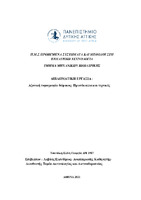| dc.contributor.advisor | Λαβδάς, Ελευθέριος | |
| dc.contributor.author | Τσοντάκη, Ελένη Γεωργία | |
| dc.date.accessioned | 2021-06-17T08:47:19Z | |
| dc.date.available | 2021-06-17T08:47:19Z | |
| dc.date.issued | 2021-06-16 | |
| dc.identifier.uri | https://polynoe.lib.uniwa.gr/xmlui/handle/11400/700 | |
| dc.identifier.uri | http://dx.doi.org/10.26265/polynoe-551 | |
| dc.description | Διπλωματική | el |
| dc.description.abstract | Μετά τη ραγδαία τεχνολογική εξέλιξη που έχει παρουσιαστεί τα τελευταία χρόνια η αξονική τομογραφία θώρακος αποτελεί αναντικατάστατη μέθοδο στην ιατρική απεικόνιση. Σκοπός της εργασίας είναι η κατανόηση του συστήματος Υπολογιστικής Τομογραφίας και η σημασία στην επιλογή του σωστού πρωτοκόλλου για την ορθή μελέτη της περιοχής του θώρακα.
Η περιγραφή , οι λειτουργίες, η αναφορά στους πνεύμονες, το διάφραγμα, το βρογχικό δέντρο, τα αγγεία, το μεσοθωράκιο και στις οστικές δομές που περιβάλλονται στο θώρακα περιγράφονται στο πρώτο κεφάλαιο. Έτσι ώστε με την παρουσίαση της ανατομίας να γίνει ανάλυση, εμβάθυνση και κατανόηση των δομών που πρόκειται να μελετηθούν.
Στη συνέχεια γίνεται η παρουσίαση και ανάλυση των συστημάτων υπολογιστικής τομογραφίας. Αναφέρονται οι γενικές αρχές λειτουργίας και η εξέλιξη των αξονικών τομογράφων από την πρώτη γενεά των συστημάτων μέχρι και σήμερα. Τα τμήματα που απαρτίζουν έναν αξονικό τομογράφο όπως η γεννήτρια και η λυχνία των ακτίνων Χ, οι κατευθυντήρες, οι ανιχνευτές, οι θάλαμοι ιονισμού, το σύστημα λήψης δεδομένων καθώς και η λειτουργία αυτών. Οι τεχνικές παραθύρων και η προετοιμασία του εξεταζόμενου που απαιτείται πριν την πραγματοποίηση μιας αξονικής περιγράφονται στο δεύτερο κεφάλαιο.
Στο τρίτο κεφάλαιο της εργασίας γίνεται αναφορά στις παραμέτρους της ποιότητας εικόνας σε ένα σύστημα αξονικού τομογράφου και πως επηρεάζονται αυτές. Η σημασία της χωρικής διακριτικής ικανότητας, του θορύβου, της ασάφειας και της διακριτικής ικανότητας χαμηλής αντίθεσης είναι καθοριστική για την ιατρική εικόνα.
Στο τελευταίο κεφάλαιο περιγράφονται τα πρωτόκολλα εξετάσεων του θώρακα με αξονική τομογραφία. Αναλύονται οι παράμετροι του κάθε πρωτοκόλλου ξεχωριστά και πως αυτές επηρεάζουν την εικόνα. Τέλος εξετάζονται όλα τα δεδομένα που συντελούν στην καταλυτική απόφαση για τη σωστή επιλογή πρωτοκόλλου. | el |
| dc.format.extent | 62 | el |
| dc.language.iso | el | el |
| dc.publisher | Πανεπιστήμιο Δυτικής Αττικής | el |
| dc.rights | Αναφορά Δημιουργού - Μη Εμπορική Χρήση - Παρόμοια Διανομή 4.0 Διεθνές | * |
| dc.rights | Attribution-NonCommercial-NoDerivatives 4.0 Διεθνές | * |
| dc.rights.uri | http://creativecommons.org/licenses/by-nc-nd/4.0/ | * |
| dc.subject | Αξονική τομογραφία | el |
| dc.subject | Πρωτόκολλο | el |
| dc.subject | Πνευμονική εμβολή | el |
| dc.subject | Θώρακας | el |
| dc.title | Αξονική Τομογραφία Θώρακος- Πρωτόκολλα και Τεχνικές | el |
| dc.title.alternative | Chest Computed Tomography- Protocols and Techniques | el |
| dc.type | Μεταπτυχιακή διπλωματική εργασία | el |
| dc.contributor.committee | Glotsos, Dimitris | |
| dc.contributor.committee | Kostopoulos, Spiros | |
| dc.contributor.faculty | Σχολή Μηχανικών | el |
| dc.contributor.department | Τμήμα Μηχανικών Βιοϊατρικής | el |
| dc.contributor.master | Προηγμένα Συστήματα & Μέθοδοι στη Βιοϊατρική Τεχνολογία | el |
| dc.description.abstracttranslated | Following the rapid technological advancements in recent years, Computed Tomography (CT) scans have arguably become an irreplaceable method in medical imaging. The purpose of this thesis is to deepen our understanding on various CT systems while illustrating the importance in choosing suitable protocols to examine the chest cavity.
The first chapter contains detailed descriptions of the anatomy and function of the lungs, diaphragm, bronchial tree, mediastinum, blood vessels and bone-densities surrounding the chest cavity. Understanding the anatomy and functionality of each organ/region individually, is a pivotal prerequisite to their respective examination.
In sequence, CT scanning systems are introduced by firstly describing the underlying principles behind this technique. Subsequently, the evolution of CT scanners is presented, starting from the first generation to the current state-of-art systems. Additionally, all components of a typical CT scanner such as the generator, X-ray source, the targeting ring, detectors, ionization chambers and the data acquisition system, are listed along with a detailed overview of their functionality. Available windowing techniques, as well as recommended protocols for adequate preparation of the patient for a CT scan are also described, within the second chapter.
Furthermore, the third chapter refers to the plethora of parameters that contribute to the image formation and influence its quality within a CT scanner. The significance of achieving high spatial resolution for medical imaging is underlined, while considering potential sources of limitations such as background/signal noise and low amplitude contrast.
Ultimately, chest cavity CT examination protocols are listed within the last chapter. Respective parameters of individual protocols are analyzed focusing on their potential influence on the image generation, with the aim to guide the decision-making leading to the selection of suitable examination protocol. | el |


